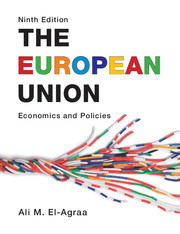Book contents
- Frontmatter
- Contents
- Figures
- Tables
- Boxes
- Contributors
- Preface
- A reader’s guide
- Abbreviations
- 1 General introduction
- Part I EU history, institutions and legal dimension
- 2 A history of European integration and the evolution of the EU
- 3 EU institutions
- 4 The legal dimension in EU integration
- 5 The EU economy
- Part II EU market integration
- Part III EU monetary integration
- Part IV The single European market
- Part V EU budget and structural policies
- Part VI EU external relations
- Part VII The future of the EU
- Bibliography
- Author Index
- Index
- References
2 - A history of European integration and the evolution of the EU
from Part I - EU history, institutions and legal dimension
- Frontmatter
- Contents
- Figures
- Tables
- Boxes
- Contributors
- Preface
- A reader’s guide
- Abbreviations
- 1 General introduction
- Part I EU history, institutions and legal dimension
- 2 A history of European integration and the evolution of the EU
- 3 EU institutions
- 4 The legal dimension in EU integration
- 5 The EU economy
- Part II EU market integration
- Part III EU monetary integration
- Part IV The single European market
- Part V EU budget and structural policies
- Part VI EU external relations
- Part VII The future of the EU
- Bibliography
- Author Index
- Index
- References
Summary
This book contains full coverage of all significant facets of the EU, as well as the international contexts and constraints within which they operate, with specific chapters devoted to each. There is therefore a need for a chapter providing an overall EU perspective. Also, a proper appreciation of why the EU has been created and how it has evolved would not be possible without an understanding of the history of European unity. This is because in a world presently dominated by immediate considerations, recently bordering on the purely economic, the driving force behind European integration is often forgotten, and attempts to reform existing policies and to steer the EU in new directions seem to be frustrated. Thus not only must the overall perspective include this wider historical dimension, but history must also colour the entirety of its exposition. This chapter is therefore devoted to these considerations and comes in two main sections. The first provides a very brief history of European unity – brief, since otherwise this book would become too long; those interested in a detailed and comprehensive coverage may consult the voluminous literature on the subject, including, inter alios, Haas (1958), Palmer and Lambert (1968), Lipgens (1982) and, for modern aspects, Wallace (1990) and Gillingham (2003). The second offers a bird’s-eye view of the evolution of the EU.
A short history of European unity
Most, if not all, actual steps taken to achieve economic and political unity in Europe originated after 1945. However, the idea of European unity is deeply rooted in European thinking. History shows that a number of proposals and arrangements have been designed to create it. In the fourteenth century, the idea of a united Christendom inspired Pierre Dubois to propose a European Confederation to be ruled by a European Council of wise, expert and faithful men. In the seventeenth century, the duc de Sully desired to keep peace in Europe by means of a ‘European army’. In 1693 William Penn, the English Quaker, then the eponymous governor of Pennsylvania, wanted the creation of ‘An Imperial Dyet, Parliament or State of Europe’, as set out in his Essay towards the Present and Future Peace of Europe. In the nineteenth century Pierre-Joseph Proudhon was strongly in favour of the formation of a ‘European Federation’ and predicted that the twentieth century would witness an era of federations, forecasting disaster in the absence of such a development.
- Type
- Chapter
- Information
- The European UnionEconomics and Policies, pp. 19 - 37Publisher: Cambridge University PressPrint publication year: 2011



